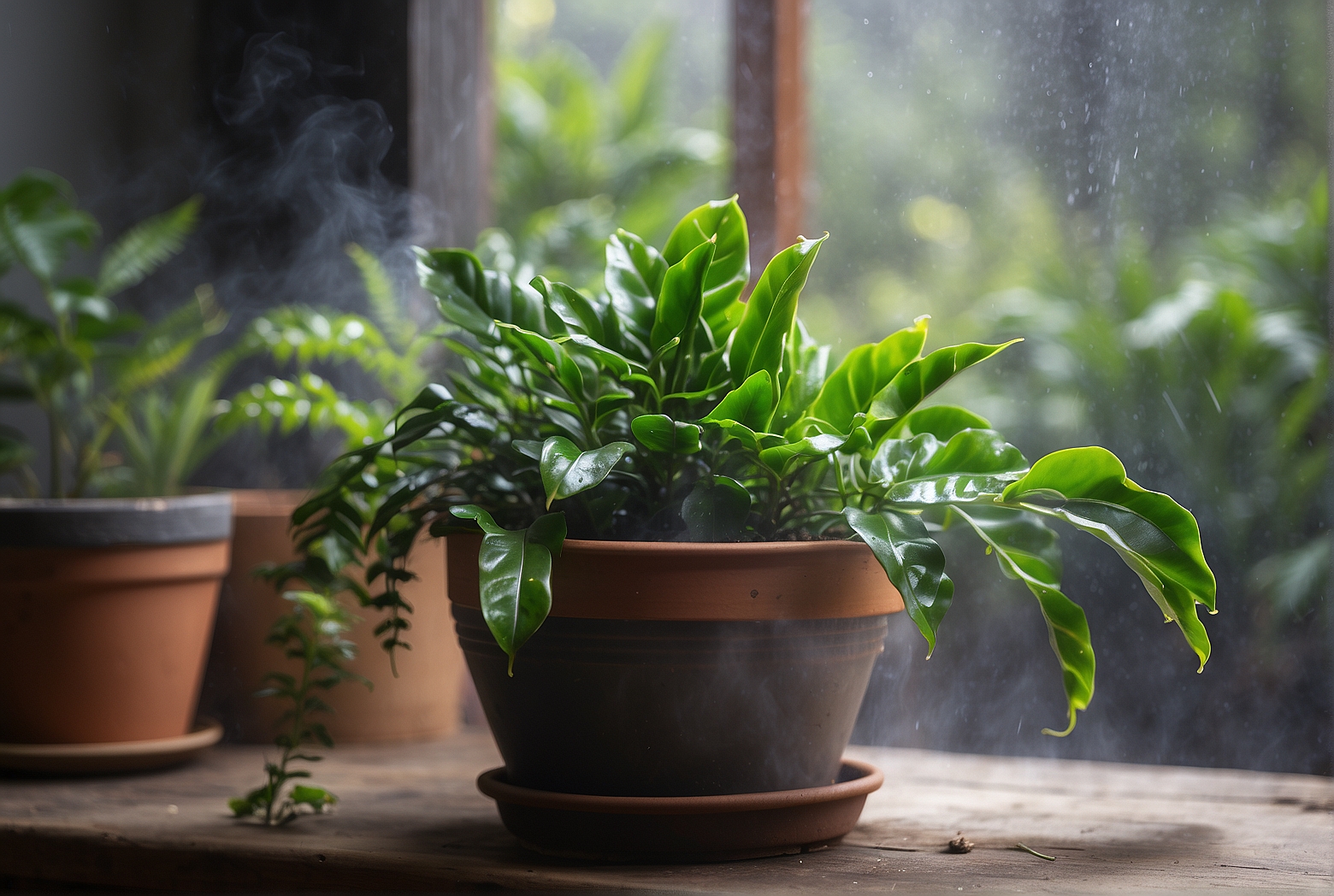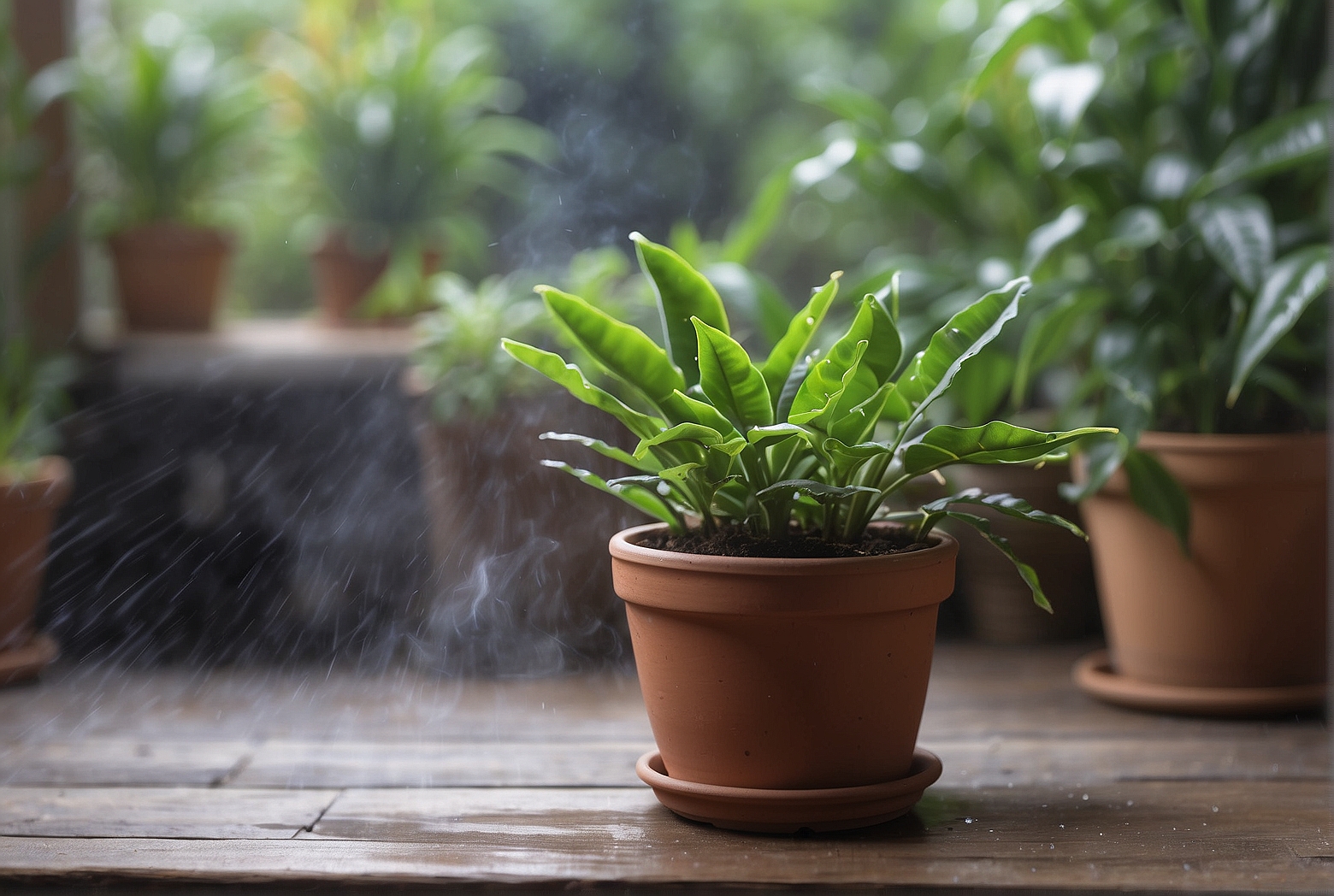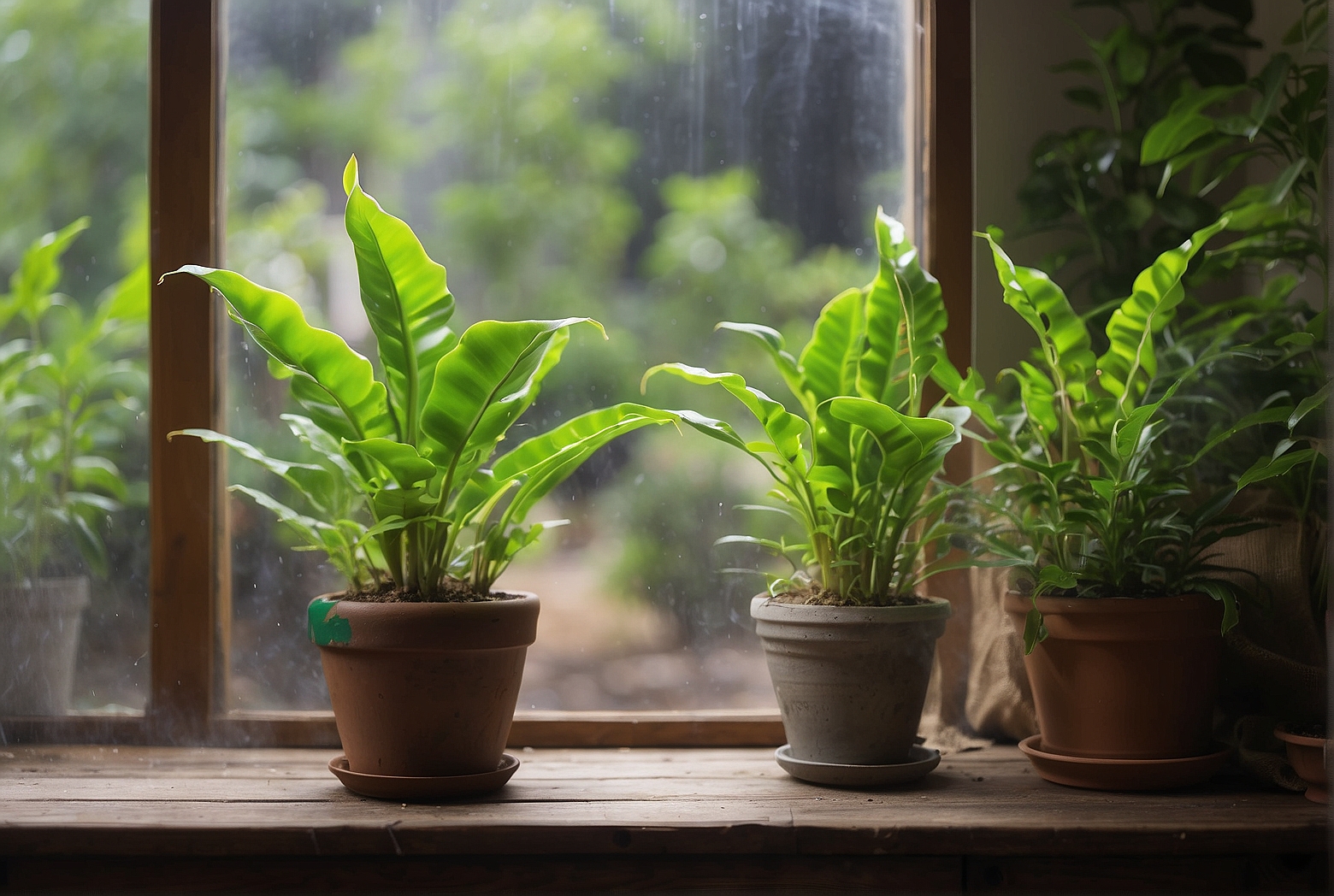Last Updated on April 10, 2024 by Tony Manhart
Are you a plant lover looking to take care of your ZZ plant but unsure if misting is beneficial? Well, you’ve come to the right place! In this article, we’ll explore the topic of misting ZZ plants and whether it truly benefits their overall health. Many plant enthusiasts swear by misting as a way to increase humidity and improve plant growth, but does this apply to ZZ plants as well? Let’s find out!
Understanding ZZ Plants
Basic Characteristics of ZZ Plants
ZZ plants, also known as Zamioculcas zamiifolia, are a popular choice for indoor plant enthusiasts. They have unique characteristics that contribute to their popularity. ZZ plants have thick, fleshy leaves that are dark green in color, giving them a distinct appearance. They are known for their ability to tolerate low light conditions, making them suitable for interior spaces with limited natural sunlight. Additionally, ZZ plants are renowned for their excellent drought tolerance, making them a low-maintenance option for plant lovers.
Environmental Preferences of ZZ Plants
To ensure the optimal growth and well-being of your ZZ plants, it is essential to understand their specific environmental preferences. ZZ plants thrive in moderate to bright indirect light. While they can tolerate low light conditions, placing them in a location with bright indirect light will promote healthier and lusher growth. These plants prefer temperatures ranging from 65°F to 75°F (18°C to 24°C), making them well-suited for indoor environments.
Common Care Practices for ZZ Plants
Proper care practices are vital to maintaining the health and longevity of ZZ plants. Regular watering is crucial, but ZZ plants are sensitive to overwatering, so it’s important to allow the soil to dry out between waterings. Fertilizing ZZ plants with a well-balanced, water-soluble fertilizer every two to three months during the growing season can help promote healthy growth. Another important aspect of ZZ plant care is dusting the leaves regularly to ensure optimal photosynthesis and leaf health.

What Does Misting Entail?
Definition of Misting
Misting refers to the act of spraying fine droplets of water onto a plant’s foliage and surrounding environment. It is typically done using a spray bottle or mister, allowing the water to disperse evenly and lightly over the plants.
Purpose of Misting
The primary purpose of misting is to increase the moisture levels in the immediate environment of the plants. It helps to mimic the natural humidity levels that certain plants, like ZZ plants, thrive in. Misting also aids in cleaning the leaves, removing dust and debris that may accumulate over time.
Benefits of Misting for Plants
Misting offers several benefits for plants, including the promotion of healthier foliage and increased moisture uptake. It can also help alleviate dryness in indoor environments, where central heating or air conditioning can cause low humidity levels. Additionally, misting can create a cooling effect, refreshing the plants and potentially reducing stress.
Potential Benefits of Misting ZZ Plants
Moisture Increase in Air Surrounding ZZ Plants
Misting ZZ plants can significantly increase the moisture levels in the air surrounding them. This is particularly beneficial in dry indoor environments where the humidity levels may be low. By providing a more humid environment, misting helps to create an optimal atmosphere for ZZ plants to thrive and maintain their moisture requirements.

Enhanced Humidity Levels
ZZ plants are native to Eastern Africa, where humidity levels tend to be higher than in many other regions. Misting ZZ plants helps recreate the humid conditions they are accustomed to, promoting healthier growth and preventing leaf dryness. Adequate humidity levels also support the overall well-being of the plant and create a more comfortable environment.
Dust Removal and Improved Leaf Health
Misting serves as a natural method to remove dust that settles on the leaves of ZZ plants. Dust can obstruct the leaf’s ability to photosynthesize and may encourage pests. By gently misting the foliage, you can effectively clean the leaves and improve their overall health and appearance.
Stimulated Growth for Young ZZ Plants
Young ZZ plants may benefit from misting as it can promote root growth and overall development. Misting provides an additional source of moisture, allowing the plants to absorb essential water through their roots and enhance growth. This is especially helpful during the early stages of a ZZ plant’s life when they are establishing their root system.
Considerations for Misting ZZ Plants
ZZ Plants’ Native Environment
Considering the native environment of ZZ plants can provide insight into their preferences regarding misting. These plants naturally grow in regions with high humidity, which suggests that misting can be beneficial. However, it is important to strike a balance and avoid over-misting, as excessive moisture can lead to problems such as root rot.
Potential Risks of Over-Misting
While misting has its benefits, it is crucial to be cautious and avoid overdoing it. Over-misting ZZ plants can create excessively moist soil, leading to root rot and other fungal infections. It is crucial to find the right balance and monitor the plants’ response to misting to ensure they are not becoming waterlogged.
Monitoring ZZ Plants’ Response to Misting
Observe how your ZZ plants respond to misting to determine whether it is helping or hindering their overall health. Pay attention to signs of stress or leaf discoloration, as they may indicate improper misting practices. Adjust the frequency and intensity of misting based on the plants’ individual needs and responses.
Other Moisture-Boosting Techniques
Misting is not the sole method to boost moisture levels for ZZ plants. Additional techniques, such as using a pebble tray, grouping plants together, or employing a plant humidity dome, can help create a more humid environment. Experimenting with different moisture-boosting techniques can help you find the most effective approach for your ZZ plants.
Determining the Need for Misting
Signs of Low Humidity Stress in ZZ Plants
By familiarizing yourself with the signs of low humidity stress, you can determine whether misting is necessary for your ZZ plants. Common signs of low humidity stress include browning leaf tips, wilting, and overall decline in health. If you notice these symptoms, misting may be beneficial in increasing the moisture content in the air and alleviating stress.
Monitoring Moisture Levels in the Environment
It is important to monitor the moisture levels in the environment where your ZZ plants are located. Hygrometers are useful tools for measuring humidity levels. Ideally, ZZ plants thrive in humidity levels between 40% and 60%. If the levels are consistently below this range, misting can be a helpful solution.
Observing ZZ Plants’ Overall Health
The overall health of your ZZ plants can serve as an indicator of their need for misting. If the plants appear vibrant, with glossy leaves and healthy growth, misting may not be required. However, if the leaves are dull, dry, or show signs of stress, misting can potentially improve their well-being.
Proper Technique for Misting ZZ Plants
Choosing the Right Spray Bottle
Selecting a suitable spray bottle is essential for misting ZZ plants effectively. Opt for a bottle with a fine mist setting that allows for a gentle and even distribution of water droplets. Avoid misting with bottles that produce a strong jet of water, as it can damage the leaves or dislodge soil.
Using Clean, Filtered Water
To prevent the accumulation of harmful minerals on the leaves, it is recommended to use clean, filtered water for misting. Tap water may contain chlorine, fluoride, or other chemicals that can negatively impact the plant’s health. Avoid using water directly from water softeners or water high in salt content, as it can be detrimental to ZZ plants.
Misting Frequency and Timing
Maintaining the proper misting frequency is crucial for the health of ZZ plants. Misting every two to three days during dry periods or when the surrounding air feels exceptionally dry is generally sufficient. Avoid misting too frequently as it can lead to over-saturation and waterlogging.
Proper Mist Coverage and Avoiding Waterlogging
When misting ZZ plants, it is important to cover the leaves adequately without causing waterlogging. Aim to mist the leaves evenly, ensuring that no excess water accumulates on the foliage or in the plant’s crown. Excess water can attract pests and promote fungal growth, potentially harming the plant.
Alternatives to Misting
Grouping ZZ Plants Together
One alternative to misting ZZ plants is grouping them together. Placing multiple ZZ plants in close proximity can create a microclimate with higher humidity levels. The plants release moisture through transpiration, collectively increasing the humidity within the group.
Using a Humidifier
Humidifiers are excellent devices for increasing humidity levels in indoor spaces. By placing a humidifier near your ZZ plants, you can create an environment that mimics their natural habitat. This can be particularly beneficial during winter months when indoor heating systems tend to reduce humidity levels.
Placing ZZ Plants in a Pebble Tray
A simple yet effective method to raise humidity levels around ZZ plants is by using a pebble tray. Fill a shallow tray with water and place a layer of pebbles or stones at the bottom. Position the ZZ plants on top of the pebbles, ensuring that the plant’s roots do not come in contact with the water. As the water evaporates, it increases the moisture content in the air surrounding the plants.
Employing a Plant Humidity Dome
Another option to boost humidity for ZZ plants is by utilizing a plant humidity dome. These clear, plastic domes create a mini greenhouse effect, trapping moisture and increasing humidity levels around the plants. Place the dome over the ZZ plants, making sure to provide adequate ventilation to prevent moisture-related issues.
Conclusion
Summary of ZZ Plants’ Response to Misting
ZZ plants can benefit from misting when done correctly and in moderation. Misting provides a boost in moisture levels, recreating the humid conditions that these plants prefer. It can enhance overall leaf health, stimulate growth in young ZZ plants, and improve the aesthetics of the foliage. However, it is crucial to monitor the plants’ response and avoid over-misting to prevent waterlogging and potential damage.
Considering Individual ZZ Plant Needs
Remember that each ZZ plant is unique, and their individual needs may vary. Observing your plants’ overall health, monitoring environmental moisture levels, and understanding their native habitat can help you determine whether misting is beneficial for your specific ZZ plants. By considering these factors and employing proper misting techniques, you can provide optimal care and create a thriving environment for your ZZ plants.
Tony Manhart is a passionate gardener who has been tending to gardens for over 20 years. He takes pride in creating beautiful outdoor spaces with plants, trees, and shrubs that can thrive in any environment. He loves to share his knowledge with others and has taught classes on gardening basics and advanced techniques. He is committed to sustainability, using natural and organic methods to create and maintain gardens. He also works with local organizations to create green spaces for communities. When he’s not gardening, Tony enjoys hiking, reading, and spending time with his family.


